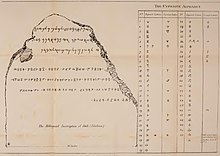| Idalion bilingual | |
|---|---|
 Idalion Bilingual at the British Museum in 2007 | |
| Created | c. 388 BC |
| Discovered | 1869 Dali, Nicosia, Cyprus |
| Discovered by | Robert Lang |
| Present location | London, England, United Kingdom |
| Language | Phoenician |


The Idalion bilingual is a bilingual Cypriot–Phoenician inscription found in 1869 in Dali, Cyprus.[2] It was the key to the decipherment of the Cypriot syllabary, in the manner of the Rosetta Stone to hieroglyphs.[3] The discovery of the inscription was first announced by Paul Schröder in May 1872.[4] It is dated to 388 BCE. The Phoenician inscription is known as KAI 38 and CIS I 89.
It was discovered by Robert Hamilton Lang in his excavations at the Temple of Idalium (modern Dali, Cyprus), whose work there had been inspired by the discovery of the Idalion Tablet in 1850. The stone was found in the centre of the temple, together with the five other Idalion Temple inscriptions. The stone is thought to have been a pedestal for a statue, as there is an apparent dowel hole in the top.[5]
Lang wrote of his discovery:[6]
The most valuable monument uncovered by my excavations is unquestionably the bilingual inscription in Cyprian and Phoenician, engraved on marble; an inscription which, I feel confident, will ultimately prove the means of enabling philologists to decipher the Cyprian alphabet ... The bilingual inscription proves also that, the two alphabets, Phoenician and Cyprian, had a contemporaneous existence.
It is currently in the archives of the British Museum, with identification number 125320.[5] It was exhibited at the Fitzwilliam Museum in Cambridge in 2018.[3]
- ^ "base; votive offering; block". British Museum. Retrieved 9 January 2021.
- ^ Journal of the American Oriental Society. American Oriental Society. 1880. pp. 93–.
- ^ a b CREWS Display: The Idalion Bilingual
- ^ Paul Schröder, 6 May 1872, Über einige Fragmente phönikischer Inschriften aus Cypern, 6. Mai. Sitzung der philosophisch-historischen, Monatsberichte der Königlichen Preussische Akademie des Wissenschaften zu Berlin; Königliche Preussische Akademie der Wissenschaften: [Footnote]: "Diese zuletzt erwähnten Inschriften, sechs an der Zahl (das Fragment einer siebenten besteht nur aus den fünf Buchstaben ...אנך אי) wurden 1869 von dem damaligen Agenten der ottomanischen Bank, jetzigem englischen Consul zu Larnaka, Hrn. Lang, zu Dali (dem alten Idalion, phön. אדיל), ungefähr eine Viertelstunde südlich vom Dorfe, zugleich mit einer grofsen Menge von Statuen, Statuetten, Köpfen, Reliefs, Terracotten, griechischen und cypriotischen Inschriften u. s. w. ausgegraben und befinden sich jetzt im britischen Museum."
- ^ a b British Museum BM 125320
- ^ J. Murray (1878). "NARRATIVE OF EXCAVATIONS IN A TEMPLE AT DALI (IDALIUM) IN CYPRUS, BT R. H. LANG ESQ., WITH OBSERVATIONS ON THE VARIOUS ANTIQUITIES FOUND THEREIN, BY R. S. POOLE, ESQ., KEEPER OF THE COINS AND MEDALS, BRITISH MUSEUM. (Read November 16, 1871.)". Transactions of the Royal Society of Literature of the United Kingdom. Royal Society of Literature (Great Britain): 51.